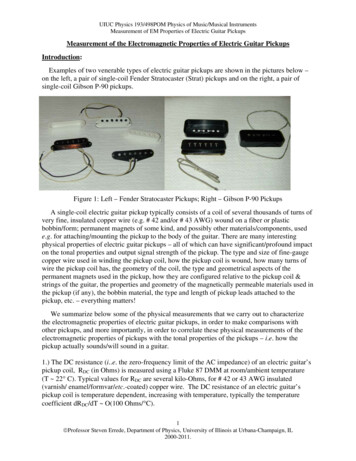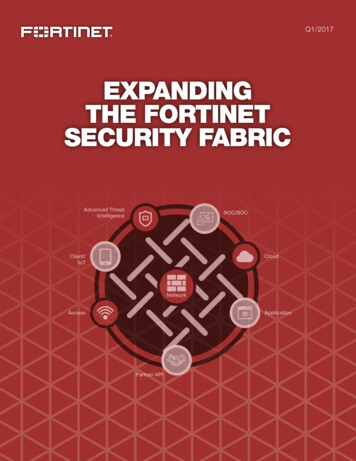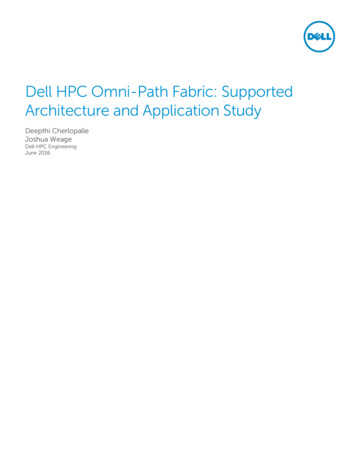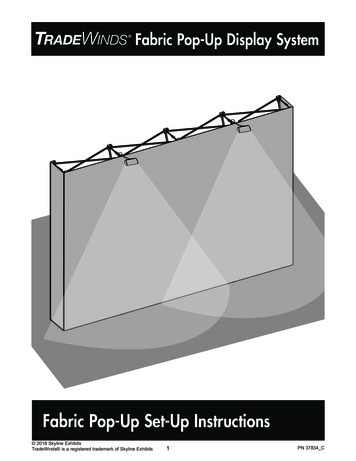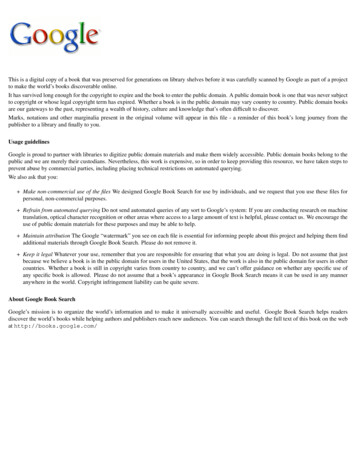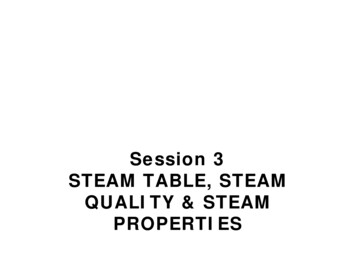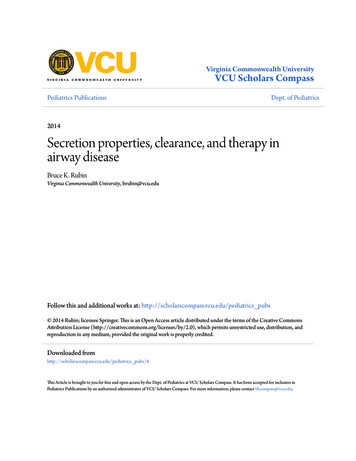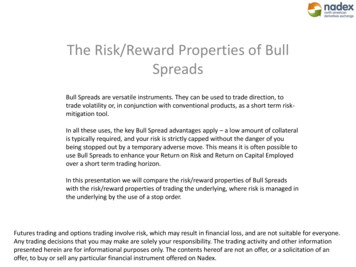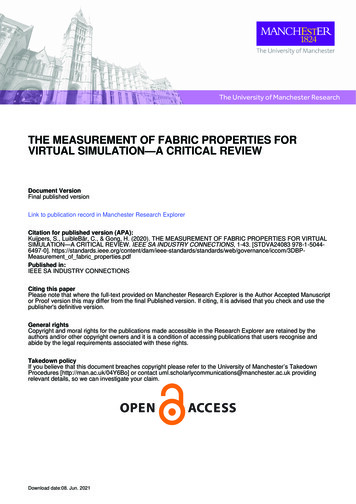
Transcription
The University of Manchester ResearchTHE MEASUREMENT OF FABRIC PROPERTIES FORVIRTUAL SIMULATION—A CRITICAL REVIEWDocument VersionFinal published versionLink to publication record in Manchester Research ExplorerCitation for published version (APA):Kuijpers, S., LuibleBär, C., & Gong, H. (2020). THE MEASUREMENT OF FABRIC PROPERTIES FOR VIRTUALSIMULATION—A CRITICAL REVIEW. IEEE SA INDUSTRY CONNECTIONS, 1-43. [STDVA24083 978-1-50446497-0]. rds/standards/web/governance/iccom/3DBPMeasurement of fabric properties.pdfPublished in:IEEE SA INDUSTRY CONNECTIONSCiting this paperPlease note that where the full-text provided on Manchester Research Explorer is the Author Accepted Manuscriptor Proof version this may differ from the final Published version. If citing, it is advised that you check and use thepublisher's definitive version.General rightsCopyright and moral rights for the publications made accessible in the Research Explorer are retained by theauthors and/or other copyright owners and it is a condition of accessing publications that users recognise andabide by the legal requirements associated with these rights.Takedown policyIf you believe that this document breaches copyright please refer to the University of Manchester’s TakedownProcedures [http://man.ac.uk/04Y6Bo] or contact uml.scholarlycommunications@manchester.ac.uk providingrelevant details, so we can investigate your claim.Download date:08. Jun. 2021
IEEE SA WHITEINDUSTRYCONNECTIONSREPORTPAPER IEEE SA INDUSTRY CONNECTIONSTHE MEASUREMENT OF FABRICPROPERTIES FOR VIRTUALSIMULATION—A CRITICAL REVIEWAuthored by Sandra (A.A.M.) Kuijpers, Amsterdam Fashion Institute, Netherlands Christiane LuibleͲBär, University of Art and Design Linz, AustriaR. Hugh Gong, University of Manchester, UK 3 Park Avenue New York, NY 10016Ͳ5997 USA
TRADEMARKS AND DISCLAIMERSIEEE believes the information in this publication is accurate as of its publication date; such information is subject tochange without notice. IEEE is not responsible for any inadvertent errors.The ideas and proposals in this document are the respective author’s views and do not represent the views of theaffiliated organization.ACKNOWLEDGEMENTSThis work is undertaken as part of the key area focus of the 3D Retail Coalition Innovation Committee to gain insight inthe measurement of fabric properties for virtual simulation to pave the path for standardization of the measurementmethods and its output data.The Institute of Electrical and Electronics Engineers, Inc. 3 Park Avenue, New York, NY 10016-5997, USACopyright 2020 by The Institute of Electrical and Electronics Engineers, Inc.All rights reserved. February 2020. Printed in the United States of America.PDF:STDVA24083978-1-5044-6497-0IEEE is a registered trademark in the U. S. Patent & Trademark Office, owned by The Institute of Electrical and Electronics Engineers,Incorporated. All other trademarks are the property of the respective trademark owners.IEEE prohibits discrimination, harassment, and bullying. For more information, visit 26.html.No part of this publication may be reproduced in any form, in an electronic retrieval system, or otherwise, without the prior writtenpermission of the publisher.Find IEEE standards and standards-related product listings at: http://standards.ieee.org.2IEEE SA INDUSTRY CONNECTIONS PROGRAMCopyright 2020 IEEE. All rights reserved.
NOTICE AND DISCLAIMER OF LIABILITY CONCERNING THE USE OFIEEE SA INDUSTRY CONNECTION DOCUMENTSThis IEEE Standards Association (“IEEE SA”) Industry Connections publication (“Work”) is not a consensus standarddocument. Specifically, this document is NOT AN IEEE STANDARD. Information contained in this Work has been created by,or obtained from, sources believed to be reliable, and reviewed by members of the IEEE SA Industry Connections activitythat produced this Work. IEEE and the IEEE SA Industry Connections activity members expressly disclaim all warranties(express, implied, and statutory) related to this Work, including, but not limited to, the warranties of: merchantability;fitness for a particular purpose; non-infringement; quality, accuracy, effectiveness, currency, or completeness of the Workor content within the Work. In addition, IEEE and the IEEE SA Industry Connections activity members disclaim any and allconditions relating to: results; and workmanlike effort. This IEEE SA Industry Connections document is supplied “AS IS” and“WITH ALL FAULTS.”Although the IEEE SA Industry Connections activity members who have created this Work believe that the informationand guidance given in this Work serve as an enhancement to users, all persons must rely upon their own skill andjudgment when making use of it. IN NO EVENT SHALL IEEE-SA OR ICAP MEMBERS BE LIABLE FOR ANY ERRORS OROMISSIONS OR DIRECT, INDIRECT, INCIDENTAL, SPECIAL, EXEMPLARY, OR CONSEQUENTIAL DAMAGES (INCLUDING,BUT NOT LIMITED TO: PROCUREMENT OF SUBSTITUTE GOODS OR SERVICES; LOSS OF USE, DATA, OR PROFITS; ORBUSINESS INTERRUPTION) HOWEVER CAUSED AND ON ANY THEORY OF LIABILITY, WHETHER IN CONTRACT, STRICTLIABILITY, OR TORT (INCLUDING NEGLIGENCE OR OTHERWISE) ARISING IN ANY WAY OUT OF THE USE OF THIS WORK,EVEN IF ADVISED OF THE POSSIBILITY OF SUCH DAMAGE AND REGARDLESS OF WHETHER SUCH DAMAGE WASFORESEEABLE.Further, information contained in this Work may be protected by intellectual property rights held by third parties ororganizations, and the use of this information may require the user to negotiate with any such rights holders in orderto legally acquire the rights to do so, and such rights holders may refuse to grant such rights. Attention is also called tothe possibility that implementation of any or all of this Work may require use of subject matter covered by patentrights. By publication of this Work, no position is taken by the IEEE with respect to the existence or validity of anypatent rights in connection therewith. The IEEE is not responsible for identifying patent rights for which a license maybe required, or for conducting inquiries into the legal validity or scope of patents claims. Users are expressly advisedthat determination of the validity of any patent rights, and the risk of infringement of such rights, is entirely their ownresponsibility. No commitment to grant licenses under patent rights on a reasonable or non-discriminatory basis hasbeen sought or received from any rights holder.This Work is published with the understanding that IEEE and the IEEE SA Industry Connections members are supplyinginformation through this Work, not attempting to render engineering or other professional services. If such servicesare required, the assistance of an appropriate professional should be sought. IEEE is not responsible for thestatements and opinions advanced in this Work.3IEEE SA INDUSTRY CONNECTIONS PROGRAMCopyright 2020 IEEE. All rights reserved.
TABLE OF CONTENTAbstract . 51.0Introduction . 62 .0Fabric Properties, Existing Measurement Principles, and Devices . 82.1 Fabric Measurement Background . 82.2 Bending Properties According Standard Cantilever Method . 82.3 Kawabata Evaluation System (KES) . 82.4 Fabric Assurance by Simple Testing (FAST) . 112.5 Fabric Analyzer By Browzwear (FAB) . 132.6 CLO FABRIC KIT 2.0 (CFK2.0) . 162.7 OPTITEX Fabric Testing Unit (FTU) . 192.8 Fabric Touch Tester (FTT) . 212.9 Zwickroell . 222.10 Measurement Principles Similarities and Differences . 263.0SWOT Analysis of the Measurement Technologies .294.0Conclusion and Future Work.375.0Citations .39
THE MEASUREMENT OF FABRICPROPERTIES FOR VIRTUALSIMULATION—A CRITICAL REVIEWABSTRACTThis investigation is undertaken based on the indicated improvements for fabric simulations, defined during the paneldiscussion “Driving the Uniformity of Material Measurements for Accurate Virtual Simulation” at the ProductInnovation Apparel Conference (PI Apparel) in Berlin 2017, by experts from industry and academia. According to theexpert panel, there is no coherency between methods used to measure the fabric properties and the simulated resultsof the same fabric among the different software packages. In praxis, fashion brands use different 3D software packagesand need to measure a fabric with different methods to obtain the same fabric properties. In addition to the timeinvestment, the simulated results for the same fabric vary significantly between the different software packages. Theexperts indicated the lack of standardization in material measurements, the lack of correlation between the data of thedifferent measurement systems, and the lack of correlation between the simulated results of the different softwarepackages for the same material. The contributions of the panel were followed up during the next edition of PI Apparelin the United States and resulted in the 3D Retail Coalition (RC) innovation committee to work on the indicated areas toimprove the efficiency of material measurements. Moreover, this topic was further discussed during the PI ApparelConference at Lago Maggiore in 2019 within the panel discussion "How Can We Collectively Achieve theStandardisation of Fabric Measurements for Digital Materials?"This paper investigates, on the one hand, the suitability of the current available measurement technologies forretrieving fabric parameters for precise virtual fabric and garment simulations. The focus is on the main propertiesrequired by the software packages—bending, shear, tensile and friction—aiming to identify and specify the mostsuitable methods to retrieve mechanical fabric properties and to start a standardization process for fabricmeasurements for virtual simulations.Seven fabric measurement methods and their output data are reviewed, namely the Kawabata Evaluation System(KES), the Fabric Assurance by Simple Testing (FAST), the Fabric Touch Tester (FTT), the CLO Fabric Kit 2.0, the FabricAnalyser by Browzwear (FAB), the Optitex Mark 10, and the cantilever principle. A set of fabrics with differentmechanical behavior and physical drape has been tested with the FAB method. Other measurement methods havebeen discussed with expert users. In addition, fabrics have been tested with ZwickRoell’s (ZwickRoell) measuringsystems applying various standard measurement methods, developed for similar materials. This publication will give foreach property an overview of the different measurement methods, as well as recommendations based on theiraccuracy. Further, a SWOT analysis is provided. The outcome of this research can be used to pave the foundation forfurther work on the standardization of the fabric measurement.5IEEE SA INDUSTRY CONNECTIONS PROGRAMCopyright 2020 IEEE. All rights reserved.
1INTRODUCTION1.1 BACKGROUNDIn recent years, the fashion industry has been increasingly shifting to use simulations for virtually assessing newproducts before they are actually produced [1], [2], [3]. 1 Even if it is impossible to simulate a product with 100%accuracy since all real influencing factors cannot be known, the virtual prototype has to be precise enough so thatimportant decisions can be taken within the product development process. For a 2D pattern optimization, which is donewith millimeter precision, the virtual prototype should be in the same range of precision. Depending on the field ofapplication, simulations approach reality with various mechanical models that consider forces and impulses and reducethe influencing factors to the most important ones. Fabrics are complex non-linear viscoelastic materials that, whensubjected to stress, flow and only gradually come to rest when the force is removed. Their simulation is not easy, astheir behavior is difficult to describe and predict. Fabrics must have sufficient strength and at the same time they mustbe flexible, elastic, and easy to pleat and shape. The knowledge of the viscoelastic behavior of a material is based onempirical data from characterization experiments. The accuracy of virtual garment simulations is dependent on themechanical model of the simulation system and the precision of fabric input parameters, derived from fabric physicaland mechanical fabric properties [4].With regards to the accuracy of the mechanical model of simulation systems, earlier cloth simulation systems werenot able to precisely simulate garments and, therefore, largely simplified the complex fabric behavior. Accurate fabricinput parameters were not needed. More recently, algorithms are optimized to such an extent that more accuratesimulations have become possible (see [5] [15]).As defined during the panel discussion “Driving the Uniformity of Material Measurements for Accurate VirtualSimulation” [16], a few of the struggles the industry faces regarding the implementation of 3D virtual technology arethe lack of uniformity in measurement technology, the lack of uniformity in units, and the lack of correlation betweenvirtual samples created based on the same fabric when using different software solutions.The purpose of this investigation is to find the most suitable method to retrieve mechanical
PROPERTIES FOR VIRTUAL SIMULATION—A CRITICAL REVIEW . shear, tensile and friction—aiming to identify and specify the most suitable methods to retrieve mechanical fabric properties and to start a standardization process for fabric measurements for virtual simulations. Seven fabric measurement methods and their output data are reviewed, namely the Kawabata Evaluation System Author: Sandra Kuijpers, Christiane LuibleͲBär, Hugh GongPublish Year: 2020

